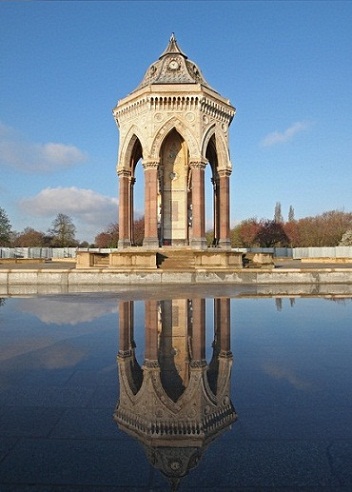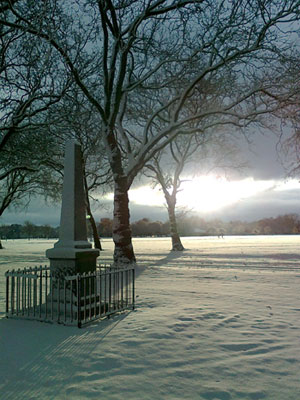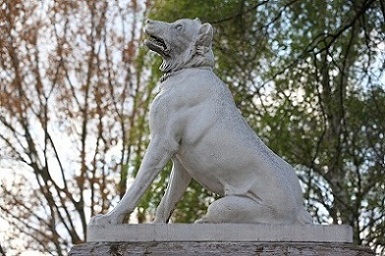History

 The need for a park in the East End of London became apparent when the population grew rapidly in the early 19th century with the development of the docks, industry and overcrowded housing that led to poor health and low life expectancy.
The need for a park in the East End of London became apparent when the population grew rapidly in the early 19th century with the development of the docks, industry and overcrowded housing that led to poor health and low life expectancy.
The first official acknowledgment of the need for a park in the East End of London came in the 1839 Annual Report of the Registrar General of Births, Deaths and Marriages, which recorded a mortality rate far higher than for the rest of London, brought about by massive overcrowding, insanitary conditions and polluted air.
The report stated: "… a park in the East End of London would probably diminish the annual deaths by several thousands… and add several years to the lives of the entire population."
This was followed in 1840 by a petition to Queen Victoria, signed by 30,000 local residents, urging the formation "within the Tower Hamlets, of a Royal Park”.
There were no open spaces in the East End of London, and there were fears that disease would spread from the stinking industries and slum population of 400,000.
This was the first public park to be built in London specifically for the people. The Act of Parliament passed in 1841 made it the first to be planned in the country, and indeed the first in the world, specifically intended to meet the needs of the surrounding communities.
The government bought poor quality land that had been used for market gardens, grazing and gravel digging. The land was flat, with poor soil and little water, but was cheaper than an alternative and larger site nearer the Thames.
 In 1841 James Pennethorne, architect to the Commissioners of Woods and Forests, prepared an initial design that included a grand entrance, a perimeter drive with elegant housing and a parkland landscape of trees and grass.
In 1841 James Pennethorne, architect to the Commissioners of Woods and Forests, prepared an initial design that included a grand entrance, a perimeter drive with elegant housing and a parkland landscape of trees and grass.
It was an instant success, with local people using the park as early as 1843, before works were completed.
Pennethorne’s design underwent several changes, the first of which was to include a boating lake with three islands in the west of the park.
In 1847 a pagoda, which had formed the entrance to the Chinese Exhibition at Hyde Park Corner, was acquired and erected on the largest of the islands. Unfortunately, the magnificent and elaborate bridge, designed by Pennethorne, was never built at the time. Instead, a rustic bridge provided access to the island, and there were rustic shelters, a cascade, fountain and boathouse.
The site was extended 1872 when land originally set aside for residential development was incorporated into the park. In April 1873, Queen Victoria visited the park, which she had been instrumental in establishing and which bore her name.
Victoria Park was established as a place of horticultural excellence with fantastic bedding that was described in great detail in the gardening press.
Surplus plants were handed out to local people. The park proved immensely popular, especially on Sundays when large crowds came to hear speakers on a variety of topics. They gathered in open spaces around the Victoria Fountain, an elaborate drinking fountain donated by Angela Burdett Coutts, philanthropist and heiress to Coutts Bank, who undertook much work to relieve poverty in the East End.

Many of the original features of the park have been lost or have deteriorated. Many parts of the site were bombed during World War II and have not been restored, some of which – such as the pagoda and the bridges to the island – were in such a poor stage of repair that they had to be demolished.
In 1987 a great storm further damaged the park, when it uprooted many mature trees. Despite the loss of many of the park buildings and features, local people led successful campaigns to protect the park from proposed road schemes. The lido was also closed and demolished during this period. A playground was created on the site of the eastern bathing lake to serve the many communities who lived in this area of London.
Despite the losses the park has suffered over time, Victoria Park remains a well-loved institution for the people of London. In heritage terms the park is still of national importance as signified by its inclusion as a Grade 2 park on the English Heritage Register of Parks and Gardens of Special Historic Interest.
The park has passed through a number of managing organisations – from the Metropolitan Board of Works in 1887, transferring to the London County Council in 1889, then the Greater London Council in 1965, then to Tower Hamlets in 1986 (initially, with the borough of Hackney through a joint management board), becoming the sole responsibility of Tower Hamlets in 1994.
In 2011 major restoration and improvement works began in Victoria Park with £12m being spent by Tower Hamlets Council and HLF Lottery Fund. The pagoda was returned to the island in the lake and the Dogs of Alcibiades (picture above) received a refurbishment, as did the Burdett-Coutts fountain. A new eastern hub building including a café were added next to a new adventure playground and the park in general received a large tidy-up.